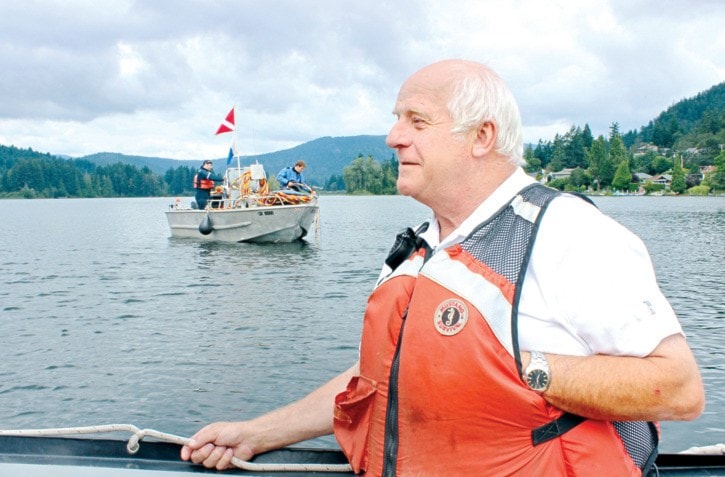When Lanny Seaton was a younger man courting the girl that would become his wife, Langford Lake was one of the places the couple spent time together. Seaton would boat over to the beach to pick up his girlfriend and then head out to teach her how to water-ski.
“On the water there was a lot of algae,” Seaton recalled. “It was an incentive to stay on your skis because if you fell in it there’d be green algae all over your skin.”
In 1984, the province brought in aerators to add oxygen to the lake in an effort to help the fisheries as well as the aesthetics of the lake.
The first attempt failed but a larger aerator added the following year managed to keep the green slime away for decades. However, after 30 years, wear and tear affected the efficiency of the aerator and it was finally removed from the lake on Tuesday (July 24).
Divers were busy at the site removing all hoses and debris associated with the old aerator, and preparing the site for a new one that is expected to arrive later next month.
At about 12,000 pounds, the new hypolimnetic aerator is so big it needs to be brought in by a Sikorsky Sky-crane.
The massive helicopter will itself be an attention-getter when it flies over the region next month. An exact date has not been pinned down yet.
The slime, which also kills fish that are added to the lake, is caused by phosphorous and potassium that leeched into the lake from a potato field once located where City Centre Park is now.
Development decades ago changed the natural drainage of the area, allowing fertilizers and pesticides from the farm to remain trapped in the lake.
Once the new aerator is installed, just the very top of it will be visible in the lake. The 14 metre device will float in a section of the lake that’s about 16 metres deep.
Essentially it helps keep the lake stay stratified so that the nutrients from the old potato field don’t cause algae blooms throughout the water. The aerator adds oxygen to the depths, preventing them from turning into a dead zone when fish seek cooler waters during the summer months.
“Fisheries did a study and came up with the size of aerator that we needed,” Seaton said.
The project will cost Langford about $250,000, though the municipality will get $100,000 back from the Habitat Conservation Trust Fund over the next two years.
editor@goldstreamgazette.com
